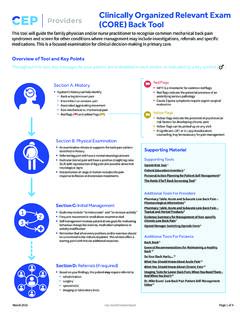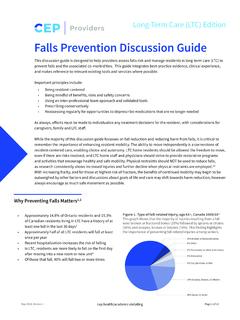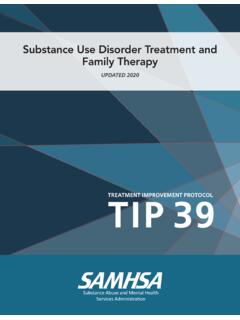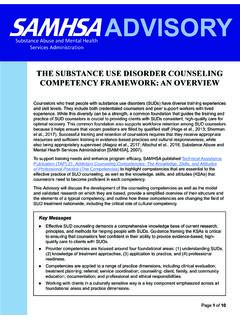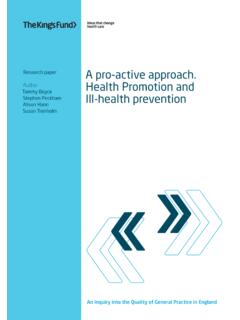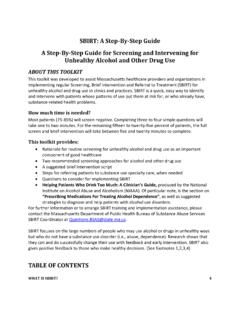Transcription of Managing Benzodiazepine Use in Older Adults
1 June 2019 Page 1 of 12 INDICATIONS OF Benzodiazepine USE DISORDER 12 Deteriorating function despite increasing dose Dishonesty with respect to prescriptions ( frequent reports of loss or theft of medications and/or routine early refill requests) Involvement with law-enforcement Non-oral route of administration Active misuse of another substance Diversion or other substance-dealing behaviourIf patient presents with possible indications of a Benzodiazepine use disorder, diagnose the patient using the DSM-5 criteria for Sedative, Hypnotic, or Anxiolytic Use Disorder. 13 SECTION A: Potential risks and benefits of benzodiazepinesBenzodiazepines are not the preferred treatment for anxiety disorders, insomnia or panic disorder among Older Adults . 1-4 As patients age, their bodies respond to medications differently, and some medications become less safe than others. It is important to re-evaluate all medications as a patient approaches the age of 65.
2 Re-evaluating the risks and benefits of concurrent medications is a routine part of medicine. It is particularly important to review the use of benzodiazepines, given the patient safety risks associated with the use of this medication in advanced age, as discussed in this tool is designed to help primary care providers assess and discuss with their patients 65 years of age or Older , the potential risks and benefits of benzodiazepines. This tool also contains steps to support primary care providers in safely discontinuing, starting or continuing to prescribe benzodiazepines for their Older Benzodiazepine Use in Older AdultsPOTENTIAL RISKS Older Adults have an increased sensitivity to benzodiazepines and decreased metabolism of long-acting agents All benzodiazepines increase the risk of cognitive impairment, delirium, falls,fractures and motor vehicle accidents in Older Adults Insomnia - NNH for any harm at 2 weeks = 6 3 Why is the patient taking/starting a Benzodiazepine ?
3 Anxiety disorders Insomnia Panic disorder Seizure disorders Alcohol withdrawal Short-term use (<4 weeks)See Section B: Discontinuing benzodiazepinesSee Section D: Alternatives to benzodiazepinesSee Section C: Starting and continuing benzodiazepinesDetermine whether a Benzodiazepine is appropriate or problematic 7 Ask patients what they take the Benzodiazepine for"What concerns did you originally start the Benzodiazepine for? Have the concerns that led to your initial Benzodiazepine prescription changed?" 10 Highlight the benefits versus risks of Benzodiazepine use for Older Adults "Although benzodiazepines sometimes offer small benefits in the short term, they stop working and become harder to wean from over time. Despite this, the serious side effects of taking benzodiazepines remain, such as cognitive impairment, delirium, falls, fractures and increased risk of motor vehicle accidents." 7"To maintain your independence, it is important to reduce or remove any medications that increase your risk of cognitive impairment, delirium, falls, fractures and motor vehicle accidents.
4 " 7"While taking a Benzodiazepine you have an increased risk of side effects: 11 5 times higher risk of memory and concentration problems 4 times higher risk of daytime fatigue 2 times higher risk of falls and fractures (hip, wrist) 2 times higher risk of experiencing a motor vehicle accident""The Benzodiazepine may cause problems with your memory and concentration which could result in an assessment of your driving privileges." 9 Talking pointsDISCUSS WITH A PATIENT THEIR USE OF BENZODIAZEPINES WHEN THE PATIENT: 8, 9 Is 65 or over Comes in for a preventative health exam Comes in for a prescription renewal or refill Has had a recent hospitalization Is admitted to long-term care Has had a recent fall Presents with new cognitive concerns or early onset dementia Reports driving difficulty or their family, caregivers or friends reports concerns Demonstrates rapid escalation of medication use Has an active substance use disorder that could trigger inappropriate or problematic use of benzodiazepines Has a potential Benzodiazepine use disorderPOTENTIAL BENEFITS Anxiety disorders: NNT at 4-6 weeks = 7 5 Insomnia: NNT at 2 weeks = 13 3 - additional minutes of sleep - less awakenings per night Panic disorder: NNT (timeframe unknown) = 5 6 Use validated assessment tools such as.
5 Set EMR reminders or patient record flags as a reminder to review a patient s Benzodiazepine use during their next appointment. 8 Encourage patients to bring up their use of benzodiazepines during their next appointment: mail or hand-out patient material to rostered patients ages 65 or over, put waiting room patient posters up or provide screening questions while patients wait for their appointments. This type of patient material is available from the Centre for Effective Practice i and the Canadian Deprescribing 2019 Page 2 of 12 CONSIDER ADJUNCTIVE THERAPY Consider cognitive behaviour therapy to improve tapering success rates Cognitive behaviour therapy has the highest success rate for patients discontinuing benzodiazepines compared to usual care or other prescribing interventions (see Patient resources, services and supports) 7 The use of pharmacological adjunctive agents has limited evidence to support success Discuss tapering and alternatives"There are more effective treatments than benzodiazepines for your [anxiety/insomnia/panic disorder].
6 " 2, 17"Many people have successfully stopped taking their Benzodiazepine the majority of people can stop through tapering." 7, 18 Talking points1. PLAN THE TAPERING Engage patients in developing a clear plan for tapering, incorporating goals and preferences regarding Benzodiazepine use 7 Discuss a goal of discontinuation versus lowest possible dose If a medication cannot be completely discontinued, a decrease in dose is still a win! Ensure patients know what is required of them ( schedule for primary care provider visits and schedule for picking up prescriptions at designated pharmacy) Reassure patients that they have control in the taper; taper can go as slow as they need and can be paused and adjusted as needed Establish the formulation to be used for tapering See Benzodiazepines available in Ontario if switching patient to another Benzodiazepine before tapering There is insufficient evidence to support the use of one particular Benzodiazepine over another (or for long- vs.)
7 Short-acting benzodiazepines) for a tapering schedule 7 Establish the dosing interval Scheduled doses are preferred over prn doses (to help with the withdrawal) Keep the dosing interval constant ( bid) Establish the rate of the taper based on the patient s health and preferences, as well as formulations available for the current Benzodiazepine (see Benzodiazepines available in Ontario) For Older Adults , it is recommended to taper the Benzodiazepine dose slowly: 25% reduction every 2 weeks and then a slower taper of every 2 weeks near the end 7 See Alternative rates for tapering Contact the patient s pharmacy to discuss the tapering plan (by phone and/or fax depending on what is feasible) Discuss with the pharmacist any pill splitting or liquid formulations necessary to accommodate tapering doses as well as packaging options for Older Adults ( dosette or blister pack)IMPORTANT INFORMATION TO COLLECT BEFORE STARTING A TAPER Current dose and duration, including prn use of Benzodiazepine Discontinuation with no taper is possible if the Benzodiazepine has been taken for <3 weeks 14 Individuals taking the equivalent of 60mg diazepam daily (see Benzodiazepines available in Ontario)
8 , or with a history of serious withdrawal reactions, should be hospitalized during acute withdrawal and tapering should be slower 14 All prescribed and over-the-counter medications that the patient is currently taking, including supplements, vitamins, and naturopathic treatments History of previous non-pharmacological and pharmacological alternatives tried for anxiety disorders, insomnia or panic disorder Understand what the patient means by "tried" and consider if the duration "tried" is long enough to evaluate efficacy/side effects An adequate trial of non-pharmacological and pharmacological alternatives is approximately 6-8 weeks Substance use history ( alcohol, cannabinoids, caffeine, nicotine) History of adverse events ( delirium, dementia or cognitive impairment, falls, fractures or motor-vehicle accidents) Baseline assessment of anxiety disorders, insomnia or panic disorder Use validated assessment tools such as, GAD-7 and PHQ (PHQ section 4 on panic disorder) 15, and the Insomnia Severity Index 163.
9 INITIATE THE TAPER AND MONITOR Decrease patient s dose by 25% (or decided upon rate) every 2 weeks until dose is close to end goal (discontinuation or lowest possible dose), then slow the dose reduction to (or decided upon rate) every 2 weeks until the end goal is reached 7 Schedule follow-up appointments with patient for every 1-2 weeks (in-person or over the phone) to monitor for expected benefits as well as severity and frequency of adverse drug withdrawal symptoms 7 See ii. Monitoring during a taper If withdrawal symptoms are bothersome for a patient or if the taper is not going well, consider maintaining the current dose for an additional 1-2 weeks before attempting the next dose reduction, then continue to taper at a slower rate if appropriate 7 SECTION B: Discontinuing benzodiazepines If taking a Benzodiazepine is no longer appropriate for a patient, then use the following steps to help them taper off of the medication or to a lower Tapering stepsJune 2019 Page 3 of 12 RATES FOR TAPERING Taper by 10% every 1 2 weeks until 20% of the original dose is reached, then taper by 5% every 2 4 weeks 14 For those experiencing severe side effects or severe anxiety, consider a slower taper of 10% every 2 weeks 14 For those taking a Benzodiazepine for panic disorder, taper the weekly dose by a maximum of 10% per week over a period of 2 4 months For those who have been taking a long half-life Benzodiazepine for only a short-term ( up to 4 weeks of clorazepate or clonazepam)
10 , taper over 1 week Alprazolam For doses <4mg/day, taper by no more than every 3 days or no more than every week 14 For doses 4mg/day, even slower tapers over 3+ months are required ( every 2 3 weeks, then slow to every 2 3 weeks when at 2mg/day) 14 TAPERING LONG-ACTING BENZODIAZEPINES Switching to long-acting benzodiazepines for a taper: Switching to long-acting benzodiazepines may be done ( diazepam, clonazepam), but this has not shown to reduce the incidence of withdrawal symptoms or improve cessation rates more than tapering shorter-acting benzodiazepines 7 Long-acting benzodiazepines do however offer advantages when tapering, including fewer rebound symptoms, constant drug levels and ease of formulation 14, 19, 20 To reduce the severity of withdrawal symptoms, keep a patient on a long-acting Benzodiazepine for at least 2 months following a switch (from a short-acting Benzodiazepine ) and before initiating a taper from the long-acting Benzodiazepine 14 To taper long-acting benzodiazepines.

